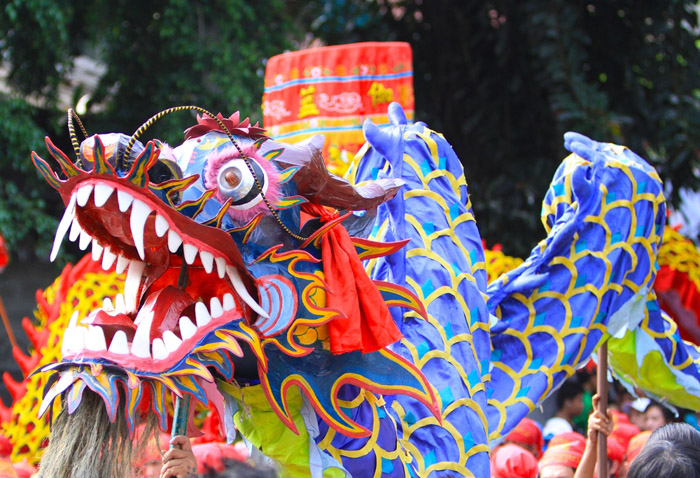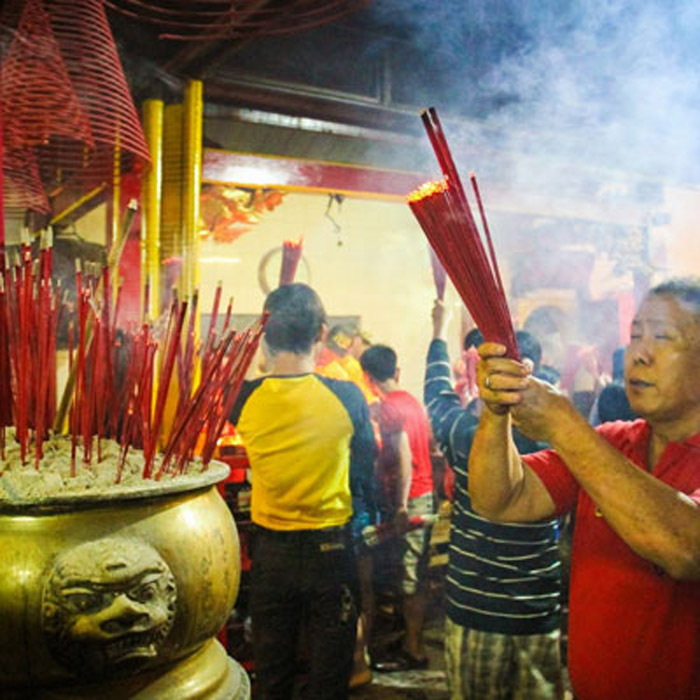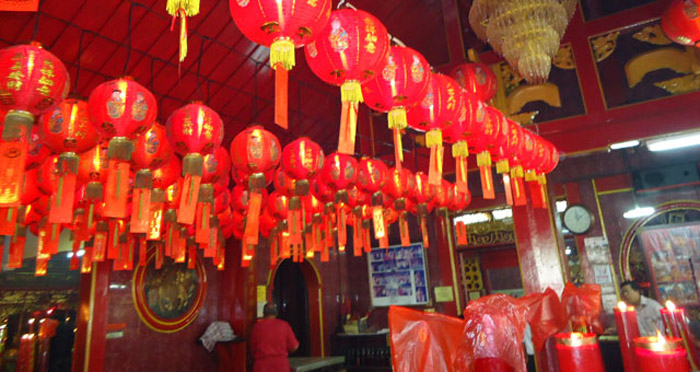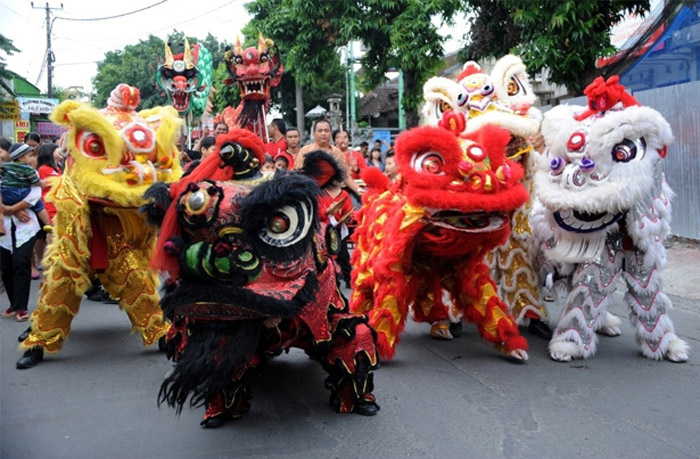 On 10th Feb, this year, the Chinese community in Indonesia will celebrate Chinese New Year or Imlek as it is commonly called. In China the holiday is also known as Spring Festival and is the most important traditional Chinese holiday. Ten years ago Chinese New Year was made an official public holiday in Indonesia. The holiday falls on a Friday this year and it will be a long weekend.
On 10th Feb, this year, the Chinese community in Indonesia will celebrate Chinese New Year or Imlek as it is commonly called. In China the holiday is also known as Spring Festival and is the most important traditional Chinese holiday. Ten years ago Chinese New Year was made an official public holiday in Indonesia. The holiday falls on a Friday this year and it will be a long weekend.
Previously Chinese culture and language were restricted in Indonesia following an attempted coup in 1965 attributed to the Indonesian Communist Party that gave rise to a backlash against communism and the Chinese. All public celebrations of Chinese religious festivals were banned. However since the reforms that came into force after the June 1999 elections, the Chinese in Indonesia are now able to openly celebrate their various festivals including Chinese New Year.
Ethnic Chinese make up approximately 3% of the population and are the largest nonindigenous community in Indonesia. Most Chinese live in cities and large towns and are active in trade and business. Many have been here for several generations and are well assimilated into Indonesian society, while others are more recent arrivals and hold strongly to the beliefs and traditions that they have brought with them from China.
The Chinese calendar is based on a combination of lunar and solar movements. The lunar cycle is about 29.5 days. In order to “catch up” with the solar calendar the Chinese insert an extra month once every few years (seven years out of a 19-year cycle). This is similar to adding an extra day on leap year. This is why, according to the solar calendar, the Chinese New Year falls on a different date each year, in the months of January or February.
For thousands of years the Chinese have named years after twelve animals. The origins of the twelve animals that are honored with a year each is rich in legends and myths. A commonly held belief is that the Buddha decided to invite all the animals of the earth to visit him on New Year’s Day. However, despite preparing for a huge party, only 12 animals arrived. They were the Rat, the Ox, the Tiger, the Rabbit, the Dragon, the Snake, the Horse, the Ram, the Monkey, the Rooster, the Dog and the Pig. The Buddha decided to honor his guests by awarding each a year of its own.
It is considered very important to make a good start to the new year. All debts must be paid so the new year is started with a clean slate. Nothing should be lent on New Year’s Day, as anyone who does so will be lending all the year. Before New Year’s Day the entire house should be thoroughly cleaned. On New Year’s Eve, all brooms, brushes, dusters, dustpans and other cleaning equipment are put away. Sweeping or dusting should not be done on New Year’s Day for fear that good fortune will be swept away.
To prepare for the celebration Chinese families decorate their homes with vases of flowers to symbolize wealth and success, live blooming plants to symbolize rebirth and new growth, platters of oranges and tangerines to symbolize abundant happiness, as well as paper decorations in red and gold. There is always a candy tray, called “The Tray of Togetherness” with eight varieties of dried sweet fruit arranged in either a circle or octagon and each item represents some kind of good fortune.
Poetic couplets are pasted on walls and doors. These are good luck sayings written on red paper often with gold trimmings and usually made up of four Chinese characters which ask for luck in terms of long life, wealth, etc., for example, “May you enjoy continuous good health” and “May the Star of Happiness, the Star of Wealth and the Star of Longevity shine on you”. The character “fu”, which means “luck”, is found on many decorations. Door gods are hung on the front door to protect the inhabitants from ghosts. Houses are brightly lit so that the god of good fortune will see them and not pass them by.
New Year’s Eve and New Year’s Day are celebrated with family gatherings, a time of reunion and thanksgiving. The extended family usually gathers at the home of the most senior member for a ceremony and big dinner on New Year’s Eve. At midnight offerings are made to the gods of the household and the family ancestors. The presence of the ancestors is acknowledged with a dinner arranged for them at the family banquet table. The spirits of the ancestors, together with the living, celebrate the onset of the New Year as one great community. The communal feast symbolizes family unity and honors the past and present generations. The offerings to the ancestors are considered the most vital of all the rituals, uniting the living members with those who have passed away. Departed relatives are remembered with great respect because they were responsible for laying the foundations for the fortune and glory of the family.
The offerings may include cups of tea, apples and oranges, cookies, sticky rice with bits of red paper stuck on, red colored Chinese dumplings without fillings that are made into various shapes such as leaves, lotus blossoms, and the animal symbol for the coming year. All these are arranged on plates in uneven numbers and everything is arranged on a red table or a table covered with a red cloth. Red symbolizes prosperity and happiness. Prayer papers are intricately folded into various shapes, and later burnt. Incense is burned to accompany the prayers, usually big incense sticks carved with dragons that may take one and a half to two days to burn completely. The incense has to be left to burn until finished and it is considered bad luck if it stops burning before it’s finished.
After the offerings have been accepted by the ancestors, a traditional meal is served with as many dishes as possible as a sign of abundance and prosperity. Vast amounts of traditional food are prepared for family and friends and probably more food is consumed during the New Year celebrations than at any other time of the year. Many of the foods served at New Year have symbolic meanings. Some foods have a name that sounds the same as a character with a lucky meaning and for some foods their shape and color are emblems of words such as happiness, prosperity, fortune or luck. Dishes served may include numerous vegetables, pork, sea cucumber, a whole fish representing togetherness and abundance, and a chicken for prosperity. The chicken must be presented with a head, tail and feet to symbolize completeness. Noodles should be uncut, as they represent long life. Fresh bean curd or tofu is never included as it is white and unlucky for New Year as the color signifies death and misfortune.
The rest of the evening may be spent playing games or praying at the temple. Letting off firecrackers on New Year’s Eve is the traditional Chinese way of sending out the old year and welcoming in the New Year. On the stroke of midnight on New Year’s Eve, all doors in the house, and even windows, have to be open to allow the old year to go out.
On New Year’s Day everyone wakes up early, as it is believed sleeping late will make you lazy the whole year. The Chinese will wash their hair the evening before New Year, often with perfumed water containing flower petals as a sign of cleansing and purification, but they avoid washing their hair on New Year’s Day because it would mean they would wash away good luck for the New Year. It is considered unlucky to greet anyone in their bedroom so that is why everyone, even the sick, should get dressed and sit in the living room. Red clothing is preferred during this festive occasion and everything has to be new. Red is considered a bright, happy color, sure to bring the wearer a sunny and bright future. It is believed that appearance and attitude during New Year’s sets the tone for the rest of the year.
In the morning children have to come to greet their parents and wish them “Gong Xi Fat Cai” (meaning “happy prosperity”) and the parents in return will give ang pau, little red envelopes or red packets decorated with lucky symbols or Chinese characters and containing money, to the children for good fortune. At Chinese New Year these red packets are given by married couples to children as well as unmarried people, however when children have grown up and got married they also give red packets to their parents. The color red is used as it is considered the most auspicious color, while the decoration may have a blessing or good wish. The symbolic giving of the money represents a wish for fortune and wealth in the coming year.
New Year’s Day is spent visiting family, particularly older relatives, and friends, while the most senior members of the family stay at home to receive guests. It is believed that the New Year activities set a precedent for the coming year and there are many taboos and superstitions associated with Chinese New Year. Everyone should refrain from becoming angry or using foul language and bad or unlucky words. Negative terms and the word “four” (Ssu), which sounds like the word for death, must not be uttered. Death and dying are never mentioned and ghost stories are totally taboo. References to the past year are also avoided as everything should be turned toward the New Year and a new beginning. If you cry on New Year’s Day, you will cry all through the year. Therefore, children are tolerated and are not spanked, even though they are mischievous. One should not use knives or scissors on New Year’s Day as this may cut off fortune. While many Chinese people in Indonesia today may not believe in these do’s and don’ts, many of the traditions and customs are still practiced.
Most Chinese merchants close their shops for at least one day and maybe up to a week. Shops and businesses will not be opened on the third day of the New Year as this is considered unlucky. They can open on the second day, but usually stay closed until the fourth day. Greeting cards for Chinese New Year are available in the stores and can be sent to Chinese friends and colleagues.

Special prayers are often made at temples during the New Year celebrations. Numerous Chinese temples, called klenteng or vihara, can be found in Jakarta, mostly in the northern and central parts of the city. The oldest temple is Vihara Dharma Bhakti in Glodok, which was originally built in 1650. Temples may be dedicated to one or all three of the main Chinese beliefs, Buddhism, Confucianism and Taoism. People worship at temples to appease their ancestors, seek knowledge about the future or ask for worldly wealth and success and harmony in daily life. Inside the temples there are usually many altars and worshippers may pray and make offerings at more than one. A statue of the deity to which the temple is dedicated stands on a central altar. Worshippers light incense sticks in multiples of three.

The traditional architecture of Chinese temples includes pitched roofs covered with clay tiles, with overhanging eaves and carved wooden beams. All surfaces are richly decorated with mythical animals, geometric motifs and the Chinese characters for happiness, wealth, good fortune and longevity. Colors are predominantly red and gold. In front of the temple there is usually an incinerator or burner for paper shapes and incense. Replicas of objects or effigies of people made from colored paper and split bamboo frames, which represent personal possessions and worldly goods, are burnt to pay respect to ancestors and send deceased family members material things to make their eternal life more comfortable. It is believed that the smoke and ashes carry the essence of the object to the deceased.
Chinese opera performances and Lion or Dragon dances, called barongsai, may be performed throughout the first few days of the Chinese New Year. The dances are accompanied by loud music played on large drums, gongs and cymbals. The use of firecrackers, drums, gongs and cymbals is to dispel evil and bring good luck.

Red is not only a lucky color for the Chinese, but also frightens off the monster Nian. Nian in Chinese means ‘year’, however, it is widely accepted that the origin of this word comes from the mythical monster that used to come and terrorize humans destroying crops and homes around the time of the New Year. The fierce Nian had an enormous mouth and could swallow people whole. The Emperor summoned a wise old man to solve this threat to mankind. The wise man approached Nian with a challenge. “Why do you choose to kill and destroy the humans who are no match for your strength?” he asked. “Prove your real power by destroying the other monsters of the earth.” Nian took up this challenge, and one year later, having destroyed all the monsters of the earth and forcing beasts of prey to retreat to the forest, he returned to terrorize mankind. However, the day he returned some children were playing with firecrackers, and they noticed that Nian was afraid of the noise. From then on each New Year firecrackers and other fireworks are used to scare away Nian, the last remaining monster on earth.
Provided by: Colliers International






